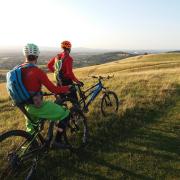On 4 May 1471 Tewkesbury became the unwitting host to one of the bloodiest battles of the War of the Roses, a battle that leaves its mark on the town to this day. There’s a Medieval Festival in July re-enacting the battle, trails around the battlegrounds and – it’s said – many ghosts. Our Hallowe’en walk takes us around the battlefield and the ghostly places in the town. The walk starts by the cross – now a memorial of another, much bloodier combat, the First World War – in the middle of town. From there, take Post Office Lane down to the River Avon, turn left and walk along the riverbank.
Why did Tewkesbury become a battleground? The rivers of Tewkesbury were to have been Margaret’s army’s saviour – but caused their destruction. The Lancastrians, commanded by Queen Margaret of Anjou, and her son, 17-year-old Edward of Westminster, had no intention of fighting there, wanting only to cross the Severn. Margaret was the wife of the deposed king, Henry VI, and the Yorkist Edward IV had ruled for nine years, only to be deposed himself in 1470. By March 1471 he was back, defeating his enemies at the Battle of Burnet, and now his forces were hurrying to cut Margaret’s off – which they most effectively did.

Tewkesbury is, of course, famous for water that cuts off the town. As you head along the riverside, you’ll see Abbey Mill, the mill for the abbey from the 12th century, rebuilt in the late 18th century, and linking you to Severn Ham, the body of land that separates the Avon from the Severn – and unsurprisingly often flooded! Head past it through the Victoria Pleasure Gardens, restored after the 2007 floods, and then through the car park, turning right onto the road and then down Lower Lode Lane, going past the steps to the leisure centre, then taking the footpath through a small wood out onto the water meadows where the battle raged.
Margaret’s troops ended up by the banks of the Severn near here, after racing north to outrun Edward. Margaret, returned from exile in France, had rallied troops in Devon, and planned to meet Jaspar Tudor’s Welsh troops a Gloucester, where they could cross the Severn. But Gloucester was closed to them, and there was no choice but to march north. Edward moved his army to Cirencester, marched up to Cheltenham, then on to Tewkesbury. At Tewkesbury Margaret was stuck. She had to cross the River Swilgate, then the Avon’s precarious causeway, before she could head to the next bridge over the Severn at Upton. What were they to do? Enter the town? Get caught in a siege? The army had no choice but to stop, the troops and horses exhausted.
As you walk up the path through the field, beside you is the Bloody Meadow, so-called because of the many who died there the next day. Amid the hedges, the ‘foul lanes’ and ‘deep dikes’ that criss-crossed the water meadows, the Lancastrians were hard to attack, but when the battle soon turned against them, it left them with nowhere to turn but the treacherous river. The sounds of battle can still sometimes be heard…
Head along the meadow until you reach a road, cross it, and head into more water meadows, cutting around the side of a housing estate and heading back towards the town. Cross the main road and turn right, then left up Abbot’s Road, and then left again onto Abbot’s Walk, following the footpath. The battle raged across this wide area, but in the end the Lancastrians fled back towards the town and the safety of the abbey.

Before we reach the abbey, turn left into the cemetery, and make your way through the graves to the monument on the far side, a reminder that tragedies can strike at any time – this is the memorial to cholera epidemics in the town in 1832 and 1849. From there, cut through onto the playing fields and you can see the abbey ahead of you. Skirt the pitch to the right, then head through gap in the hedge to a memorial to the battle at the top of the hill. At some point in the flight, word got out that the young heir to Henry VI’s throne, Edward of Westminster, just 17 and wearing a velvet doublet, was killed. Some say it was by Edward IV’s brother George, Duke of Clarence, to whom the young man, in desperation, had turned to for help.
Many of the men got into the abbey and the promise of the church’s sanctuary. Follow their footsteps out of the meadow, across the now-tiny River Swilgate, down Gander Lane and through the gateway into the abbey grounds. Entering through the south porch into the massive vaulted space of the abbey’s nave. Even in this unreligious age, it’s easy to imagine the sense of relief the men must’ve felt. But what happened next? Moans and screams have been heard inside the abbey – evidence that an atrocity took place?

The chronicle of the abbey itself says that Edward IV marched into the abbey, sword bared, while a priest was saying mass. Lancastrian blood was spilled in the church, so much that it had to be reconsecrated. A story grew up that Edward of Westminster wasn’t slain on the field of battle, but rather that he was brought alive to Edward and when he declared he had come to ‘recover my father’s heritage’, the king struck him and the Dukes of Clarence and Gloucester – the latter the future Richard III – dragged him out of the church and ran him through with their swords. We do have to remember that those are Tudor chronicles, happy, like Shakespeare’s Richard III, to slur the house of York. A ghostly figure in a velvet doublet is seen haunting the grounds. Is this the young prince? A woman in white is seen screaming just outside the abbey. Is this one of the camp followers? Or even Queen Margaret herself, grief-stricken at losing her son?
All the contemporary sources say Edward of Westminster died in battle. Edward IV entered the abbey to give thanks for his victory, and, finding several of the nobles who had conspired against him there, along with ordinary soldiers, and issued a pardon, and allowed the men to bury their dead on that holy ground – including young Edward. A plaque on the floor in the chancel says bewails the savagery of men while above in the stained-glass knights who fought in earlier wars look down and the Last Judgement plays out before us.

Whatever happened, on May 6, Edward removed several of the nobles from the church. Make your way out of the abbey and up the street towards the cross where we began. There 14 noblemen were tried and executed. Edward allowed them, too, to be buried in the abbey or its churchyard. Then he was away, off to Worcester, to pursue Margaret, who had escaped. She was caught the next day at Little Malvern Priory.
Back in Tewkesbury we are not quite done. From the cross, make you way down the High Street until you come the pub at the end, the Olde Black Bear, the oldest pub in town. There we might find one last ghost, a Lancastrian wearing a dented, tarnished breastplate, who stands at window looking out sadly towards the river that might’ve afforded him freedom.
It was Jaspar Tudor who would have the last laugh. His son, Henry, defeated Richard III at Bosworth Field in 1485 and started the Tudor dynasty. All know Richard III’s fate, but what the other so-called murderer of the prince, George, the Duke of Clarence? In 1477 he was executed for plotting against his brother Edward: drowned, it’s said, in a vat of Malmsey wine. He is also buried at Tewkesbury. But if you look for his grave, you won’t find it. Not for him the fancy chantry tombs that line the chancel. Walk around the ambulatory and you’ll see a grille in the floor where a vault lies beneath – and that is all that remains of his tomb.

ESSENTIALS
Distance: 3 miles.
Duration: 2 hours, including visiting the Abbey.
Level: Easy, town and park walking, boggy in places.
Parking: Multiple carparks in Tewkesbury
Toilets and refreshments: Touching Souls, the Abbey tearoom; Riverside Café; and the Olde Black Bear pub.
Transport links: Trains run to Ashchurch on the other side of the M5, with a bus link into the town centre. Stagecoach buses 71 from Gloucester and 41, 42 and 43 from Cheltenham.
LINKS
Route: gb.mapometer.com/walking/route_5474244
Tewkesbury Abbey: tewkesburyabbey.org.uk
Battle of Tewkesbury: tewkesbury.org.uk/news/may-4th-1471-the-battle-of-tewkesbury
Kirsty Hartsiotis is based in Stroud and available as a storyteller and speaker. She is an Accredited Arts Society lecturer. Her books include Wiltshire Folk Tales and (with Anthony Nanson) Gloucestershire Ghost Tales and Gloucestershire Folk Tales for Children. She is also the curator of decorative art at a Gloucestershire museum.



























